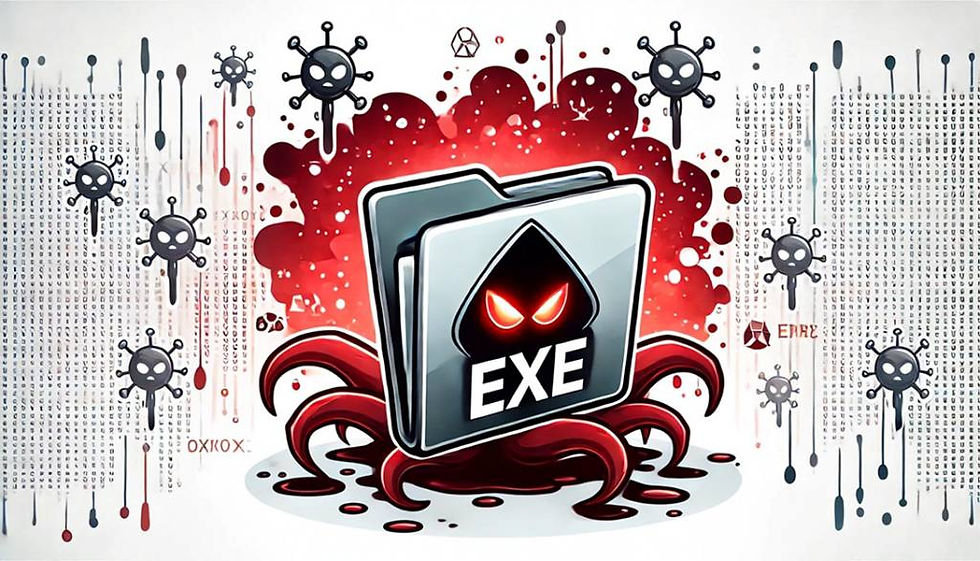
When we download files from the internet or receive them via email, we rarely think about the hidden threats they might carry. Executable files in the EXE format are particularly dangerous, as they can run programs and scripts that directly affect the system's operation. In this article, we’ll explore how to identify potentially malicious EXE files and what steps you can take to secure your computer.
Why Are EXE Files Dangerous?
The EXE format (executables) is used to run programs on Windows operating systems. These can be program installers, backup utilities, or task automation tools. The problem is that attackers often disguise malicious code as harmless programs, using EXE files to spread viruses, trojans, rootkits, and other threats.
But why EXE? The reason is that Windows trusts executable files and allows them to run with full permissions. This means a malicious EXE file can access system settings, files, personal data, and even install other programs without your knowledge.
How to Identify a Malicious EXE File?
Before downloading and running a file, especially from an untrusted source, it’s important to perform a quick check. Here’s what to look for:
Unusual File NameAttackers often use names similar to well-known programs to deceive users. For example, names like "Setup.exe," "Windows_Update.exe," or "Free_Game.exe" should raise suspicion. If the file name seems suspicious, it’s better not to risk running it.
Check the Digital SignatureA digital signature confirms that the file was released by an official developer and hasn’t been altered. To check the signature, right-click the file, select "Properties," and go to the "Digital Signatures" tab. If the signature is missing or doesn’t match the developer’s name, it could be a red flag.
Analyze with VirusTotalOne of the easiest and quickest ways to check a file for viruses is using the online service VirusTotal. This site scans uploaded files with over 70 antivirus engines and reports if the file is flagged as malicious. The process is simple:
Go to the VirusTotal website.
Upload the EXE file.
Wait for the analysis results.If the file is flagged as malicious by at least one antivirus, be cautious. However, don’t panic if only one or two engines flag it—this could be a false positive. But if most antiviruses confirm the threat, do not run the file.
How to Protect Your System from EXE Viruses?
Here are some simple yet effective ways to protect your computer from malicious EXE files:
Use Reliable Antivirus SoftwareDon’t rely solely on Windows Defender. Additional antivirus solutions like Kaspersky, Bitdefender, or Malwarebytes provide a higher level of protection and can detect threats that might be missed by the default defender.
Enable SmartScreenWindows SmartScreen is a built-in security filter that blocks the execution of unknown and potentially dangerous applications. To ensure it’s enabled:
Open Windows Settings.
Go to "Update & Security."
Find "Windows Security" and enable SmartScreen.
Keep Software UpdatedOutdated software may contain vulnerabilities that attackers can exploit. This applies not only to antivirus programs but also to the operating system, browsers, and even office software. Regular updates patch vulnerabilities and enhance system security.
Restrict Execution of Suspicious FilesYou can configure Windows to block the execution of all unknown EXE files. This can be done through Group Policy or the Registry Editor, but it requires technical knowledge and may limit the functionality of legitimate programs.
Technical Protection Measures
For advanced users, here are additional techniques to detect malicious files before execution:
Use Process ExplorerMicrosoft’s Process Explorer is a powerful tool for analyzing running processes. It can reveal which files a process is using and help detect malicious code. If a process is linked to a suspicious EXE file, it’s best to terminate it and delete the file.
Analyze Network Activity with WiresharkIf you suspect an EXE file is performing malicious network activities (e.g., sending data to remote servers), use Wireshark. This tool monitors all network traffic and helps detect suspicious connections.
Use a SandboxRunning a potentially dangerous EXE file in a sandbox allows you to test its behavior without risking your main system. Tools like Sandboxie or Cuckoo Sandbox create an isolated environment where the file can be executed and analyzed safely.
What to Do If You’re Already Infected?
If you suspect your computer has been infected by a malicious EXE file, act quickly:
Disconnect your computer from the internet to prevent data transmission to attackers.
Run a full system scan using your antivirus.
Use tools like Malwarebytes or AdwCleaner to remove unwanted programs.
As a last resort, perform a system restore or reinstall Windows.
Conclusion
Malicious EXE files can cause significant damage to your computer and data. However, by staying informed and following simple security practices, you can protect yourself and your devices. Remember, caution and timely file checks are the best allies of any Windows user.
Don’t neglect security, and regularly check your systems. After all, there will always be those on the internet who seek to exploit carelessness.
Comments